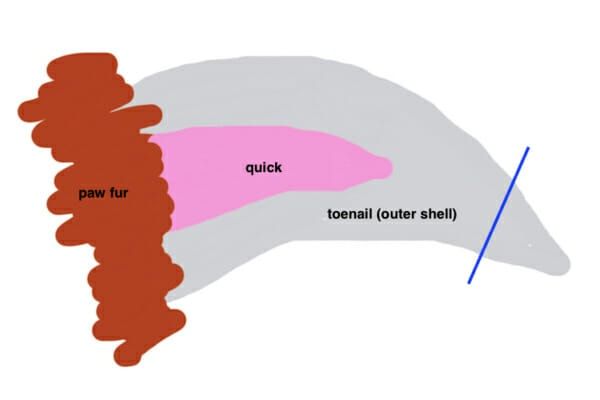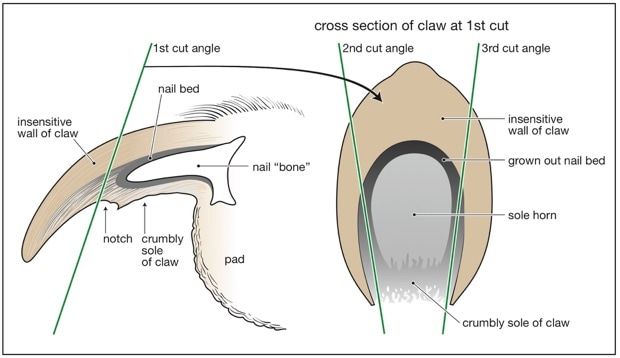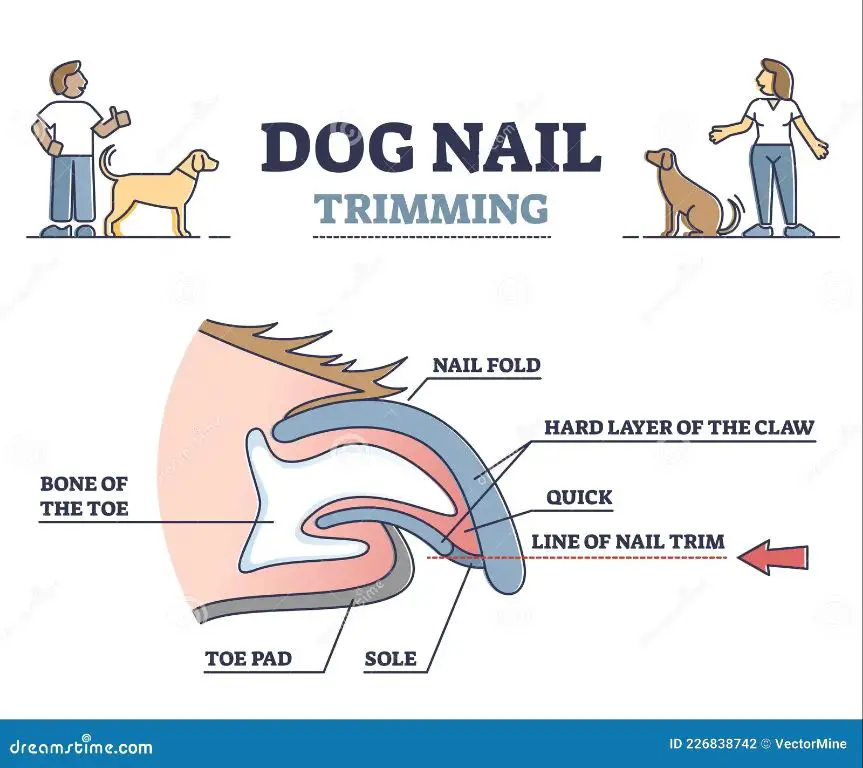Introduction
A dog’s nail is made up of different parts that serve important functions. One of the most critical parts of a dog’s nail is the nail matrix – a hollow section within the nail bed. The nail matrix produces cells that become hardened keratin, the protein that makes up the nail. This hollow section plays a key role in nail growth and health. Understanding the anatomy of a dog’s nail, including the function and location of the nail matrix, is important for proper grooming and care. Damage to this sensitive area can lead to nail disorders and deformities. Being aware of the nail matrix can help dog owners prevent injury and get prompt treatment if problems do occur.
Anatomy of a Dog’s Nail
A dog’s nail is made up of several distinct layers and parts:

Outer Shell
The outermost part of a dog’s nail is a protective keratin shell. This outer shell is similar to a fingernail in humans. It is hard and helps protect the more sensitive inner structures.
Quick
Inside the hard outer shell is tissue called the “quick.” This contains nerves and blood vessels that supply the nail. The quick recedes as the nail grows longer.
Nail Bed
Underneath the hard outer shell is soft tissue called the nail bed. This is an extension of the skin on the dog’s toe. It supplies sensation to the nail.
Nail Matrix
At the base of the nail is the nail matrix. This is the area where new nail growth originates. The nail matrix generates cells that become hardened keratin as the nail grows.
The Hollow Part – The Nail Matrix
The nail matrix is the hollow part of a dog’s nail. It sits at the base of the nail, just under the skin. This part of the nail is what produces new nail growth. The cells within the matrix rapidly divide and push outward, creating the hard nail plate that makes up the visible part of the nail.

The nail matrix can be thought of as the nail’s “quick”, which is the soft, sensitive tissue that supplies blood to the nail. When trimming a dog’s nails, it’s important not to cut into this matrix or quick, as it contains nerves and blood vessels and will bleed and be painful for the dog if cut.
Since the nail matrix generates new nail growth, it is positioned deep within the toe to be protected. The tissues surrounding the nail matrix anchor it in place inside the dog’s toe. The matrix remains internal and hollow, while the nail plate it produces grows outward to form the hard nail.
Function of the Nail Matrix
The main function of the nail matrix is to produce keratin, the key structural protein that makes up the nail plate. The nail matrix contains actively dividing cells that push out the keratin proteins, which then harden and compact together to form the nail plate. This production of keratin is what allows a dog’s nail to grow continuously.
The nail matrix cells are arranged in longitudinal columns, and the keratin they produce isextruded in sheets parallel to the surface of the nail bed. As new keratin is produced by the nail matrix and extruded forward, the older keratin at the end of the nail is gradually worn down at the tip. This constant cycle of keratin production and wear is what enables the nail to maintain its length.
Location of the Nail Matrix
The nail matrix is located in the proximal part of the nail, which is the part closest to the paw. It extends from the cuticle, which is the fold of skin surrounding the base of the nail, to the lunula, which is the whitish crescent shape near the base of the nail. The lunula represents the most distal part of the matrix that’s visible.
More specifically, the matrix starts under the cuticle and reaches upwards into the nail bed, spanning about two-thirds to three-quarters of the length of the nail from base to tip. It extends deeper proximally, with the deepest part being the germinal matrix that produces new keratin cells.

Importance of the Nail Matrix
The nail matrix is a very important part of a dog’s nail because it is responsible for generating the actual nail plate. The matrix contains keratin-producing cells that slowly push out the nail plate as new cells are produced. This is what allows a dog’s nails to continuously grow. If the nail matrix gets severely damaged, it can potentially stop nail growth permanently.
Even minor injuries to the matrix, like getting caught and partially torn, can distort nail growth. This results in nails that are deformed, brittle, or grow unevenly. Sometimes if the matrix tear is on the side, it causes the nail to grow in a curved shape. These kind of growth abnormalities are permanent once the matrix is damaged.
That’s why it’s very important to protect the nail matrix and avoid any cuts or injuries in that area. Even minimal damage to the nail bed matrix can have long-lasting effects on how the nail looks and grows for the rest of the dog’s life.
Protecting the Nail Matrix
You must take care to avoid damaging a dog’s nail matrix when trimming its nails. The nail matrix is very sensitive, and injury to this tissue can be extremely painful and lead to permanent nail damage.
The key to protecting the nail matrix is to avoid trimming the nail too short. The nail matrix extends into the nail bed, beginning about halfway down the full length of the nail. If you trim off more than half of the nail, you risk hitting the nail matrix with the clippers and causing trauma.
Signs that the nail has been trimmed too short and the matrix injured include:
- Bleeding from the nail
- The nail appears crushed or misshapen
- Your dog cries in pain or pulls its paw away
To prevent this, trim only the dead nail tissue and avoid cutting past the pinkish area inside the nail. It is better to trim a little at a time than to risk hitting this sensitive tissue. Ask your veterinarian to demonstrate proper nail trimming technique. With careful attention, you can keep your dog’s nail matrix protected.
Signs of Nail Matrix Damage
Damage to a dog’s nail matrix can result in some clear symptoms and signs. These may include:
-
Nail deformity – If the nail matrix is injured, the nail may begin to grow in deformed or misshapen.
-
Discoloration – Bruising or bleeding under the nail from matrix trauma can lead to nail discoloration. The nail may turn black, blue, purple, or reddish.
-
Bleeding – Direct injury to the nail matrix usually results in some bleeding, which is visible at the nail bed. Excessive or prolonged bleeding indicates a serious matrix injury.
These signs point to damage in the nail root and growth center. Ignoring them can lead to long-term nail abnormalities or infections. Any nail matrix symptoms should be evaluated promptly by a veterinarian.
Treatment for Nail Matrix Injuries
If the nail matrix is injured, treatment will depend on the severity of the damage. Here are some common treatment options:

Bandaging – For minor injuries, the paw and nail may just need to be bandaged to protect it while healing. A light wrap or bandage can cover the nail and cushion the nail bed.
Antibiotics – If the nail matrix is damaged enough to expose tissue, antibiotics may be prescribed to prevent infection while the nail heals. Oral or topical antibiotics can keep the area clean.
Surgery – For severe nail matrix lacerations or avulsions, surgery may be required. This involves reattaching or suturing the nail matrix tissue if part of it has been torn away. Surgery can help prevent deformity or permanent damage.
With prompt care, most nail matrix injuries can heal well over time. Protecting the sensitive nail bed tissue is key. Consulting a veterinarian is recommended, especially for significant trauma to the nail matrix area.
Conclusion
The hollow part of a dog’s nail is known as the nail matrix. This soft area underneath the nail contains nerves and blood vessels that aid in nail growth. It sits at the base of the nail bed, extending from the cuticle to the quick. The nail matrix is crucial for producing strong and healthy claws. Since it is delicate and sensitive, pet owners must take care to avoid damaging it. Signs of an injured nail matrix include nail splitting, discoloration and infection. These require prompt veterinary treatment to prevent permanent nail deformities. In summary, the hollow matrix deep within each nail allows for canine claw regeneration. Understanding its location and function is key to monitoring nail health in dogs.